Bass are the perfect fish for the plug angler. Their agility and power, the big eye, large mouth and especially their naturally aggressive nature means the bulk of their food will be taken alive in a direct predator prey conflict. Nothing appeals better to the bass’s hunting approach than a visually look-alive plug giving off sound, vibration and noise to trigger that attack.
Only 20 years ago very few anglers used plugs for bass. Since then the sport has grown rapidly and particularly so in the last decade. Back in the 80’s bass anglers fishing plugs had to use designs mainly for pike or import lures from the US. Nowadays there are plugs specifically designed for UK bass. The same can be said about rods too.
Plug fishing for bass then has come of age and is now ranked as an independent skill in the bass angler’s armoury.
SEASONS
In the south the main plugging season runs from April through to virtually Christmas. The peak period is from mid May through to early October, with August and September the hot time for numbers and for the better sized fish.
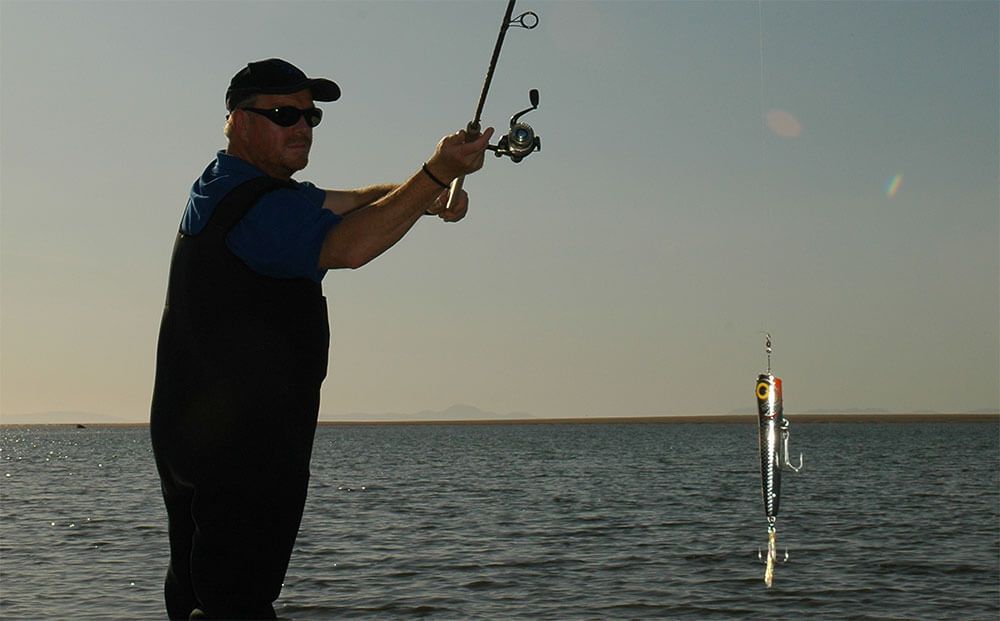
The East Coast as far as The Wash sees their season kick in around the end of May, with June to late August the peak, by September more colour in the water will affect the fishing.
Wales fishes well from late April to late June. July sees a lull as the bass move offshore on to the reefs for sandeel, but the fish come inshore again to peak between August and early October.
Bass are now being targeted by plug anglers as far north as the Cumbrian coast and Luce Bay in Scotland. The season here is shorter though taking in late May to early September with the peak fishing in August.
TACKLE
Rod length can be critical and many anglers get it wrong. For surface working plugs shorter 9ft to 9ft 6in rods casting 1 to 3ozs are best with a medium fast taper action. These are comfier to hold for long periods and less tiring when continually working the rod tip to add action to the lure. These shorter up to 9ft 6in rods also seem to punch plugs further when casting in to head winds.
Some more experienced anglers even prefer the short American style jerk rods at 7ft or less with a small multiplier reel. These can give increased casting accuracy when fishing tight in to specific feature.
Over very rough ground with surface breaking rocks and weed beds, a rod between 10ft and 11ft makes more sense. The increased length allows the plug to be steered and worked around productive snags at range much easier, plus when big fish are hooked these give extra leverage to help bully and play the fish away from snags.
The only reel choice for general fishing is a fixed spool capable of holding 250yds of 12lb mono line. Choose a reel with a metal spool, or at least a spool that has a metal lip. The smooth metal lip adds a few extra feet to the cast. A good tip is to gently polish the rim of the spool with T Cut then add a quality wax car polish. This increases the co-efficiency as the line flies over the rim of the spool.
Currently there’s a split between plug anglers, some still choose mono as their first line choice, with others going for braid.
The mono works well, but the elasticity in the line does mean you loose a little contact with the plug and requires the angler to work a little harder to get the action in the plug. Braid on the other hand gives direct contact with the lure maximising movement. The problem with braid is that it can bed in to itself when fighting a decent sized fish and cause you problems when casting next time, or worse when the fish runs out line again, plus in very clear water it can put fish off as the braided line, even in finer diameters, is very visual.
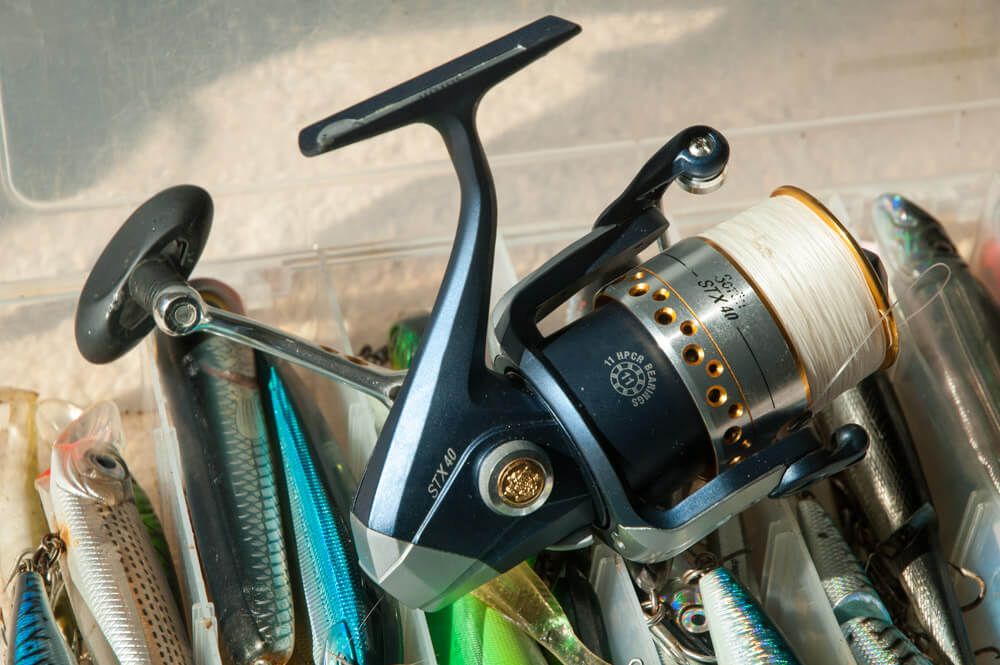
It’s a good idea to carry spools with both mono and braided line on. Choose mono between 10 and 12lbs, or 15lb braid which covers virtually all situations. The braid though is best when fishing surface popping plugs.
Essential are a good pair of Polaroid sunglasses. These help you see the plug against the water surface as well as protecting your eyes.
PLUG DESIGNS & CHOICE
Floating surface poppers are incredibly successful. These have a scooped out nose and when retrieved hold air in the nose as the plug dips below the surface creating a “pop” and also scattering spray on the water. This imitates a wounded struggling fish and is irresistible to a bass looking for easy prey.
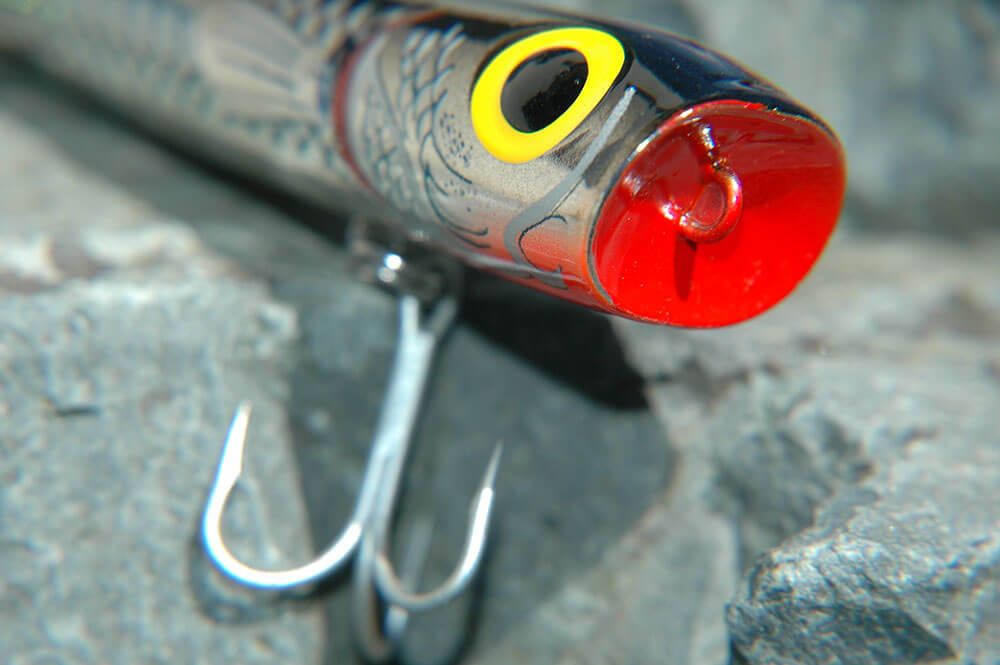
Surface poppers are perfect for working over heavy rough ground, broken ground and even over clean sand when ambushing passing bass in calm to semi rough sea conditions and in water from clear to semi coloured.
When it comes to diving plugs the angle of the front lip or vane as well as retrieve rate governs how deep the lure will dive. The more vertical angle in relation to the head the lip has the shallower the plug will dive due to water resistance. The more horizontal the lip angle the deeper the plug will dive.
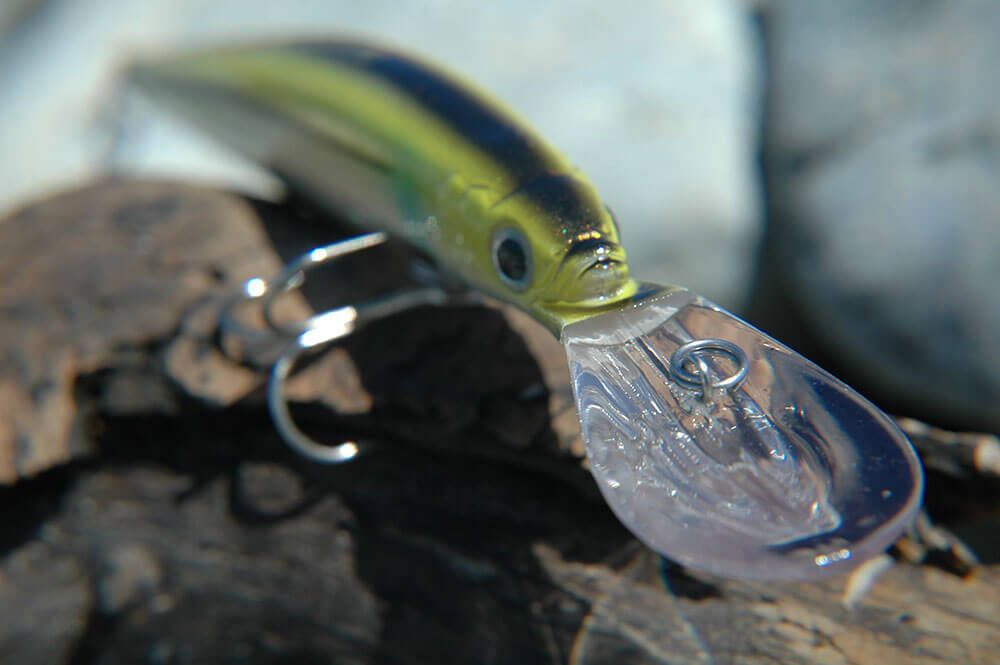
Modern sub surface diving plugs may have no lip at all. These have an angle built in to the nose that creates the sub surface pull and when retrieved sees the plug work down in the high surface layers which is a good imitator of fleeing baitfish. These are good in clear water conditions.

Floating diving plugs usually work down to about 5ft in depth and are ideal for shallowish water up to 10ft. Sinking divers, as a generalisation, can work down to 12ft or more depending on retrieve speed and are more suitable for deeper water. These are best in clear water with a high light clarity.
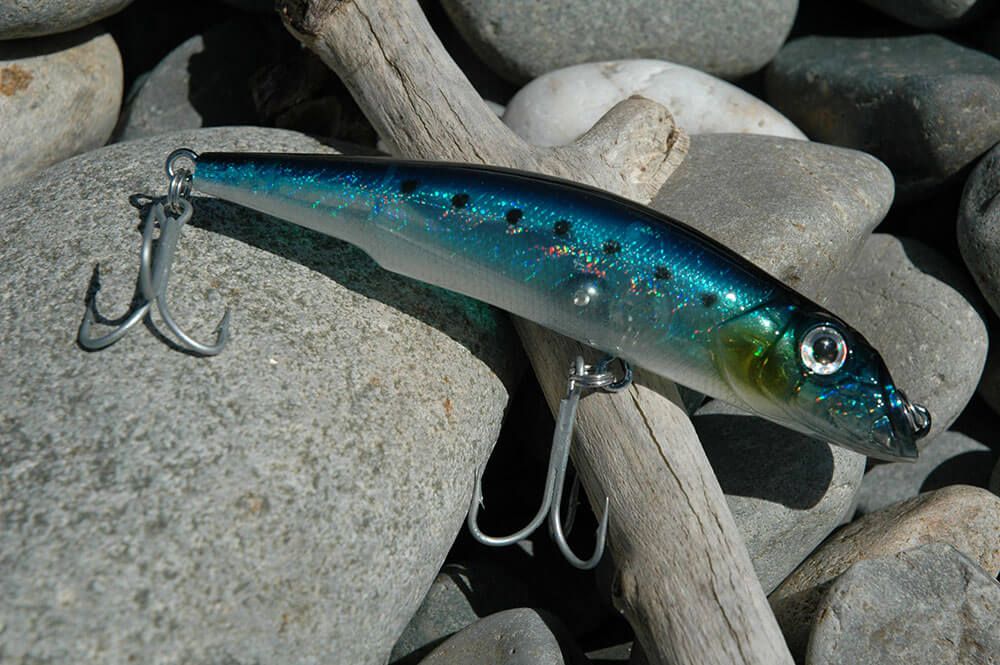
Single bodied plugs catch plenty of fish, but it’s logical that having a body in two halves will create more movement and vibration in the water. Diving plugs with segmented bodies do tend to catch you more fish. Some of the latest designs such as the Dexter Dexi-Flex have multi segments adding far more vibration and increased movement which triggers more fish response when using a diving plug. These plug types produce well in both clear and lightly coloured water.
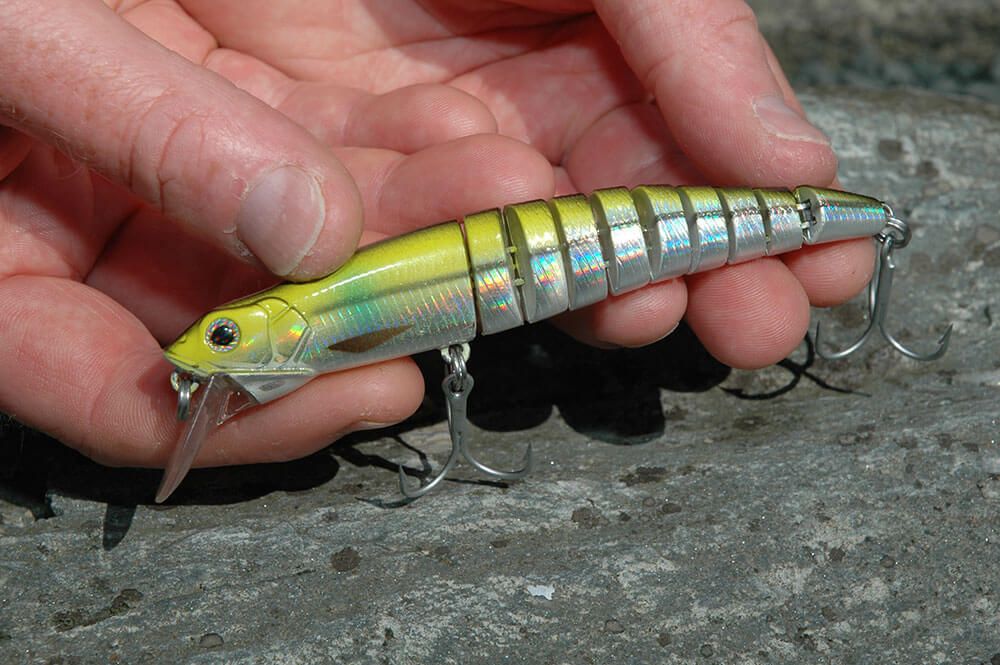
In all water clarity conditions plugs with ball-bearings added that give a metallic rattle to the plug when it’s worked can also induce more attacks, especially in coloured water when fish are using vibration as their natural attack locator with visual sighting only coming in to play at the last second. This applies to both surface working and deep diving plugs.
Also worth carrying are plugs with the line attachment not in the nose but in the forward section of the upper body. These diving style plugs will work with a sideways wobble swimming action and take a lot of fish when there are sprat and mackerel working tight to shore.
Plug colour is also important. On dark days in clearish water use a dark coloured plug to give a hard silhouette target area. On bright days with sunny conditions choose plugs with metallic blue and silver in to gain light reflection as the plugs moves in the water. In coloured seas use brighter coloured plugs with yellow, red and green in the body makeup to give a more visual target.
Bass will take plugs from 3ins up to 12ins, but plugs between 4ins and 9ins take the bulk of the fish. Little bass still take big plugs!
Think about the body shape and weight on the day. Lightweight plugs of all types are okay for close quarter work in water over 5ft deep in calm conditions where fish are likely up to 25yds out.
A long cast for a plug is a genuine 35yds. Some modern designs with a weight biased at the tail though can be cast beyond 50yds, especially with a tail wind. These should be chosen to punch through a head wind, or when working shallow water where fish are reluctant to come too close in.
Try to build up a good selection of all types of plug. You’ll get to know the more successful types and colours quickly, but always aim to change plugs after 20 minutes if you’re getting no interest.
WORKING THE PLUG
All individual plugs have a certain speed at which they perform best. Spend time getting to know the right retrieve rates of the plugs you own.
Surface poppers are generally worked at a slow pace, but with an occasional erratic sideways flick of the rod tip to induce a more dramatic movement simulating a wounded bait fish. When working surface poppers standing with the rod at a 45 degree angle away from you with the rod tip just above the water makes working the plug easier. Alternatively hold the rod directly in front of you and raised at a slight angle then flick the wrist to work the plug on the surface.
The same sideways stance is best for the diving plugs. These designs vary more, with some needing only a slow retrieve to work sub surface, but a much faster retrieve to get them deeper and to get the best action from them. You know when the plug is working as you’ll feel the “swimming” action of the plug vibrating through the line to the rod tip.
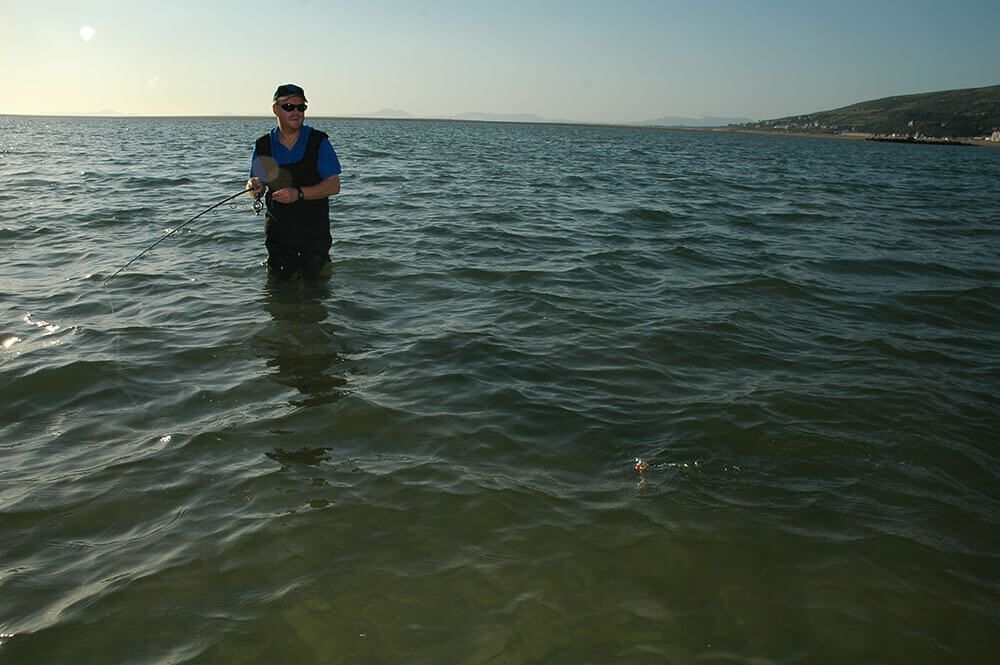
Both surface poppers and divers can benefit from the occasional pause in the retrieve. This allows a floating plug to ride upwards a little before dipping down again as you restart the retrieve. This imitates a feeding fish. A sinking plug obviously sinks a little before swimming again as the pick up line. This pause, then swim action often triggers an attack from a bass just as the plug starts to move again.
Always fully fish every cast out right to your feet. Bass have a habit of hitting the lure just as you’re ready to lift it up for casting. This is the same tactic used by trout fly anglers, the fish forced in to making a decision or missing a meal.
A good tip is if a plug has a swimming bias to the left, gently bend the eye on the plug to the right a fraction to make the plug swim straight. In turn a plug with a right swimming bias can be corrected to run straight by bending the connector eye to the left.
In clear water, using a plug with silver tinsel on the tail treble hook can induce more strikes when fish are fussy and “looking” at the lure but committing to a full on attack.
GROUND FEATURE
As in all fishing always look for ground feature. Bass will congregate in numbers and methodically work areas of rough ground, boulders and weed beds. This is the very best type of ground to work plugs over. Look for the areas where the ground is roughest, or where deeper channels link directly with the open sea and fully fish these out.
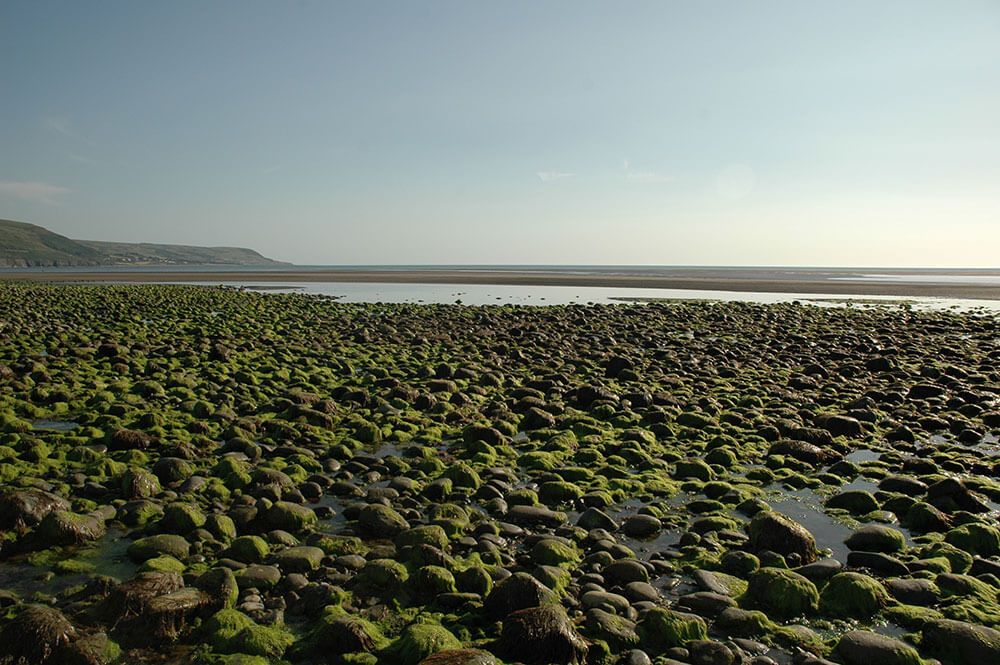
Broken ground can be just as good if the boulders are quite big with good cover for crabs and small fish to hide in.
Other obvious areas are around wooden or concrete groynes, off breakwaters, piers and jetties, also rocky outcrops on beaches and rough ground patches. All these spots are bait fish holding areas and will draw bass in.
Never neglect an ambush mark though. These are areas where bass have to pass in order to reach good feed areas close by. Typically these are lengths of beach between rocky outcrops, but especially estuary channels where the fish must pass by you to reach food rich areas inside.
WHEN TO FISH
Predatory fish will feed best at dawn and dusk, and bass are no different. When the angle of the sun drops on the water and the light starts to fade, the bass work the seabed looking upwards using the light in the sky against the surface water to silhouette prey against.
If you must fish by day, try to choose overcast days with a little chop on the water to diffuse the light penetration. Bright clear water days are the least likely to produce.
The bigger tides tend to be the most productive, especially those starting the three days before the highest spring tide of that cycle and for the first day after. That does not mean that smaller tides are not worth fishing, it’s just that the numbers of fish are likely to be less.
Bass are predictable when they feed over certain ground. On rough ground expect fish to show from low water if there is a depth of at least 5ft for the first two hours. Then they typically disappear. They show again the two hours before high water and for the first hour after.
In estuaries they can show from low water, but in daylight they tend to run up the estuary when the flood has been underway for a good couple of hours using the flow to travel quickly. You can ambush them on their way back out fishing the second to fourth hour of the ebb.
Man made structure can produce at any stage of the tide, but is usually most productive on the flood.
Choose five or six marks to plug fish, and then fish them consistently throughout all weather and tidal conditions keeping careful notes. Pinpoint when fish were caught, wind direction, sea state, water clarity, cloud cover and anything else you deem important. This build up of information is the only way to understand the true predictability of bass on the marks you fish.
Only 20 years ago very few anglers used plugs for bass. Since then the sport has grown rapidly and particularly so in the last decade. Back in the 80’s bass anglers fishing plugs had to use designs mainly for pike or import lures from the US. Nowadays there are plugs specifically designed for UK bass. The same can be said about rods too.
Plug fishing for bass then has come of age and is now ranked as an independent skill in the bass angler’s armoury.
SEASONS
In the south the main plugging season runs from April through to virtually Christmas. The peak period is from mid May through to early October, with August and September the hot time for numbers and for the better sized fish.

The East Coast as far as The Wash sees their season kick in around the end of May, with June to late August the peak, by September more colour in the water will affect the fishing.
Wales fishes well from late April to late June. July sees a lull as the bass move offshore on to the reefs for sandeel, but the fish come inshore again to peak between August and early October.
Bass are now being targeted by plug anglers as far north as the Cumbrian coast and Luce Bay in Scotland. The season here is shorter though taking in late May to early September with the peak fishing in August.
TACKLE
Rod length can be critical and many anglers get it wrong. For surface working plugs shorter 9ft to 9ft 6in rods casting 1 to 3ozs are best with a medium fast taper action. These are comfier to hold for long periods and less tiring when continually working the rod tip to add action to the lure. These shorter up to 9ft 6in rods also seem to punch plugs further when casting in to head winds.
Some more experienced anglers even prefer the short American style jerk rods at 7ft or less with a small multiplier reel. These can give increased casting accuracy when fishing tight in to specific feature.
Over very rough ground with surface breaking rocks and weed beds, a rod between 10ft and 11ft makes more sense. The increased length allows the plug to be steered and worked around productive snags at range much easier, plus when big fish are hooked these give extra leverage to help bully and play the fish away from snags.
The only reel choice for general fishing is a fixed spool capable of holding 250yds of 12lb mono line. Choose a reel with a metal spool, or at least a spool that has a metal lip. The smooth metal lip adds a few extra feet to the cast. A good tip is to gently polish the rim of the spool with T Cut then add a quality wax car polish. This increases the co-efficiency as the line flies over the rim of the spool.
Currently there’s a split between plug anglers, some still choose mono as their first line choice, with others going for braid.
The mono works well, but the elasticity in the line does mean you loose a little contact with the plug and requires the angler to work a little harder to get the action in the plug. Braid on the other hand gives direct contact with the lure maximising movement. The problem with braid is that it can bed in to itself when fighting a decent sized fish and cause you problems when casting next time, or worse when the fish runs out line again, plus in very clear water it can put fish off as the braided line, even in finer diameters, is very visual.

It’s a good idea to carry spools with both mono and braided line on. Choose mono between 10 and 12lbs, or 15lb braid which covers virtually all situations. The braid though is best when fishing surface popping plugs.
Essential are a good pair of Polaroid sunglasses. These help you see the plug against the water surface as well as protecting your eyes.
PLUG DESIGNS & CHOICE
Floating surface poppers are incredibly successful. These have a scooped out nose and when retrieved hold air in the nose as the plug dips below the surface creating a “pop” and also scattering spray on the water. This imitates a wounded struggling fish and is irresistible to a bass looking for easy prey.

Surface poppers are perfect for working over heavy rough ground, broken ground and even over clean sand when ambushing passing bass in calm to semi rough sea conditions and in water from clear to semi coloured.
When it comes to diving plugs the angle of the front lip or vane as well as retrieve rate governs how deep the lure will dive. The more vertical angle in relation to the head the lip has the shallower the plug will dive due to water resistance. The more horizontal the lip angle the deeper the plug will dive.

Modern sub surface diving plugs may have no lip at all. These have an angle built in to the nose that creates the sub surface pull and when retrieved sees the plug work down in the high surface layers which is a good imitator of fleeing baitfish. These are good in clear water conditions.

Floating diving plugs usually work down to about 5ft in depth and are ideal for shallowish water up to 10ft. Sinking divers, as a generalisation, can work down to 12ft or more depending on retrieve speed and are more suitable for deeper water. These are best in clear water with a high light clarity.

Single bodied plugs catch plenty of fish, but it’s logical that having a body in two halves will create more movement and vibration in the water. Diving plugs with segmented bodies do tend to catch you more fish. Some of the latest designs such as the Dexter Dexi-Flex have multi segments adding far more vibration and increased movement which triggers more fish response when using a diving plug. These plug types produce well in both clear and lightly coloured water.

In all water clarity conditions plugs with ball-bearings added that give a metallic rattle to the plug when it’s worked can also induce more attacks, especially in coloured water when fish are using vibration as their natural attack locator with visual sighting only coming in to play at the last second. This applies to both surface working and deep diving plugs.
Also worth carrying are plugs with the line attachment not in the nose but in the forward section of the upper body. These diving style plugs will work with a sideways wobble swimming action and take a lot of fish when there are sprat and mackerel working tight to shore.
Plug colour is also important. On dark days in clearish water use a dark coloured plug to give a hard silhouette target area. On bright days with sunny conditions choose plugs with metallic blue and silver in to gain light reflection as the plugs moves in the water. In coloured seas use brighter coloured plugs with yellow, red and green in the body makeup to give a more visual target.
Bass will take plugs from 3ins up to 12ins, but plugs between 4ins and 9ins take the bulk of the fish. Little bass still take big plugs!
Think about the body shape and weight on the day. Lightweight plugs of all types are okay for close quarter work in water over 5ft deep in calm conditions where fish are likely up to 25yds out.
A long cast for a plug is a genuine 35yds. Some modern designs with a weight biased at the tail though can be cast beyond 50yds, especially with a tail wind. These should be chosen to punch through a head wind, or when working shallow water where fish are reluctant to come too close in.
Try to build up a good selection of all types of plug. You’ll get to know the more successful types and colours quickly, but always aim to change plugs after 20 minutes if you’re getting no interest.
WORKING THE PLUG
All individual plugs have a certain speed at which they perform best. Spend time getting to know the right retrieve rates of the plugs you own.
Surface poppers are generally worked at a slow pace, but with an occasional erratic sideways flick of the rod tip to induce a more dramatic movement simulating a wounded bait fish. When working surface poppers standing with the rod at a 45 degree angle away from you with the rod tip just above the water makes working the plug easier. Alternatively hold the rod directly in front of you and raised at a slight angle then flick the wrist to work the plug on the surface.
The same sideways stance is best for the diving plugs. These designs vary more, with some needing only a slow retrieve to work sub surface, but a much faster retrieve to get them deeper and to get the best action from them. You know when the plug is working as you’ll feel the “swimming” action of the plug vibrating through the line to the rod tip.

Both surface poppers and divers can benefit from the occasional pause in the retrieve. This allows a floating plug to ride upwards a little before dipping down again as you restart the retrieve. This imitates a feeding fish. A sinking plug obviously sinks a little before swimming again as the pick up line. This pause, then swim action often triggers an attack from a bass just as the plug starts to move again.
Always fully fish every cast out right to your feet. Bass have a habit of hitting the lure just as you’re ready to lift it up for casting. This is the same tactic used by trout fly anglers, the fish forced in to making a decision or missing a meal.
A good tip is if a plug has a swimming bias to the left, gently bend the eye on the plug to the right a fraction to make the plug swim straight. In turn a plug with a right swimming bias can be corrected to run straight by bending the connector eye to the left.
In clear water, using a plug with silver tinsel on the tail treble hook can induce more strikes when fish are fussy and “looking” at the lure but committing to a full on attack.
GROUND FEATURE
As in all fishing always look for ground feature. Bass will congregate in numbers and methodically work areas of rough ground, boulders and weed beds. This is the very best type of ground to work plugs over. Look for the areas where the ground is roughest, or where deeper channels link directly with the open sea and fully fish these out.

Broken ground can be just as good if the boulders are quite big with good cover for crabs and small fish to hide in.
Other obvious areas are around wooden or concrete groynes, off breakwaters, piers and jetties, also rocky outcrops on beaches and rough ground patches. All these spots are bait fish holding areas and will draw bass in.
Never neglect an ambush mark though. These are areas where bass have to pass in order to reach good feed areas close by. Typically these are lengths of beach between rocky outcrops, but especially estuary channels where the fish must pass by you to reach food rich areas inside.
WHEN TO FISH
Predatory fish will feed best at dawn and dusk, and bass are no different. When the angle of the sun drops on the water and the light starts to fade, the bass work the seabed looking upwards using the light in the sky against the surface water to silhouette prey against.
If you must fish by day, try to choose overcast days with a little chop on the water to diffuse the light penetration. Bright clear water days are the least likely to produce.
The bigger tides tend to be the most productive, especially those starting the three days before the highest spring tide of that cycle and for the first day after. That does not mean that smaller tides are not worth fishing, it’s just that the numbers of fish are likely to be less.
Bass are predictable when they feed over certain ground. On rough ground expect fish to show from low water if there is a depth of at least 5ft for the first two hours. Then they typically disappear. They show again the two hours before high water and for the first hour after.
In estuaries they can show from low water, but in daylight they tend to run up the estuary when the flood has been underway for a good couple of hours using the flow to travel quickly. You can ambush them on their way back out fishing the second to fourth hour of the ebb.
Man made structure can produce at any stage of the tide, but is usually most productive on the flood.
Choose five or six marks to plug fish, and then fish them consistently throughout all weather and tidal conditions keeping careful notes. Pinpoint when fish were caught, wind direction, sea state, water clarity, cloud cover and anything else you deem important. This build up of information is the only way to understand the true predictability of bass on the marks you fish.

